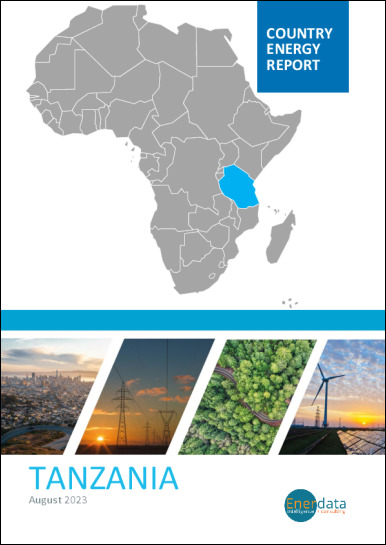- Update
-
- Format
- 3 files (PDF report, 2 Excel files)
- Pages
-
30 (Report only)
- Delivery
- Immediate by e-mail
- GENERAL OVERVIEW
- INSTITUTIONS AND ENERGY POLICY
- ENERGY COMPANIES
- ENERGY SUPPLY
- ENERGY PRICES
- ENERGY CONSUMPTION
- ISSUES AND PROSPECTS
- DATA TABLES
- ABBREVIATIONS
- GLOSSARY
Buy Tanzania energy report
Price without VAT. Depending on your statute and location, VAT might be applicable. Get in touch with us for more information.
After validation, you will immediately receive 3 files by email (one pdf report and 2 excel files containing the datasets).
Overview
This analysis includes a comprehensive Tanzania energy market report and updated datasets. It is derived from the most recent key economic indicators, supply and demand factors, oil and gas pricing trends and major energy issues and developments surrounding the energy industry. The report provides a complete picture of the country situation, dynamics, current issues and future prospects. With market data and continuous follow-up of markets news, this report brings clear and concise insights with which to tackle national energy challenges and opportunities. Browse the tabs below for a detailed table of contents, the list of graphs and tables, and details on the data files.
Highlights
- The country aims to double the share of renewables in its energy mix and to decrease energy intensity by 2.6%/year by 2030.
- Tanesco, a state-owned utility, accounts for around 80% of the power supply.
- Equinor and Shell control large gas reserves.
- Since 2011, power generation is growing rapidly, by more than 5%/year. It is dominated by gas (47%).
- Gas and coal production remains low; the country imports its entire consumption of oil products.
- Diesel and gasoline prices have increased by around 50% since 2020, following global trends.
- Biomass is supplying more than 80% of the total consumption.
- The Power System Master Plan 2020 plans an increase of 11%/year in the power capacity by 2044, to 20 GW.
- A 2.1 GW hydropower plant is expected to be commissioned in 2024.
Institutions & Energy Policy
The Ministry of Energy (MoE) is in charge of the country's energy policy and development, in particular through the Electricity & Renewable Energy Division and the Petroleum & Gas Division, which wascreated in 2017 from the partition of the Ministry of Energy and Minerals.
Energy Companies
Electricity:
The state-owned power utility Tanesco, Tanzania Electric Supply Company Limited, is tasked with the generation, purchasing, transmission, distribution, and selling of electricity to Mainland Tanzania, as well as bulk supply to Zanzibar.
Energy Supply
Oil:
Tanzania imports its entire consumption of refined products. Imports of oil products are increasing and have doubled since 2010, reaching. 3.2 Mt.
Energy Prices
Electricity:
The electricity tariffs are divided into five levels: Domestic Low Usage (D1), General (T1), Low Voltage (T2), Medium Voltage (T3), and High Voltage (T5).
The electricity tariff was 9.4 US$c/kWh for households and for small businesses (2022).
Energy Consumption
The total per capita energy consumption is around 0.39 toe (2021), more than a third lower than the average for Sub-Saharan Africa. The per capita electricity consumption was 136 kWh in 2021.
Total energy consumption increased by 3.7% in 2021 after a 1.5% decline in 2020 and a 1.3%/year progression between 2013 and 2019.
Graph: CONSUMPTION TRENDS BY ENERGY SOURCE (Mtoe)
Issues & Prospects
Electricity:
The Power System Master Plan 2020 (PSMP 2020 Update) forecasts a total capacity of 20 GW in 2044, up from 1.9 GW in 2023, with the following capacity mix: gas 6.7 GW (33%), hydro 5.7 GW (28%), coal 5.3 GW (26%), geothermal 1.0 GW (5%), wind 0.8 GW (4%), and solar 0.7 GW (4%).
- GRAPH 1: CO2-energy emissions (MtCO2)
- GRAPH 2: Installed electric capacity by source (2021, %)
- GRAPH 3: Gross power production by source (TWh)
- GRAPH 4: Power generation by source (2021, %)
- GRAPH 5: Gasoline & diesel prices (US$/l)
- GRAPH 6: Consumption trends by energy source (Mtoe)
- GRAPH 7: Total consumption market share by energy (2021, %)
- GRAPH 8: Final consumption market share by sector (2021, %)
- Economic Indicators: Annual historical data including population, GDP growth, imports and exports, inflation rate, energy security and efficiency indicators, CO2 emissions.
- Supply Indicators: Historical data including oil and gas reserves, electric and refining capacity, energy production, power production and external trade. All are detailed by energy source.
- Demand Indicators: Historical data including consumption per inhabitant, consumption trends, total consumption by energy source, final consumption by energy source and sector, and electricity consumption by sector.
- Energy Balances: Single table displaying the overall energy industry balance per annum, also graphically displayed by energy sub-segment.
- Infrastructure Projects: Covers power plant projects by energy, technology, status and operator.
The Tanzania energy market data since 1990 and up to
is included in the Excel file accompanying the Tanzania country report.
It showcases the historical evolution, allowing users to easily work with the data.
Key Data included in the excelsheet:
- Economic indicators: Annual historical economic indicators, energy security, energy efficiency and CO2 emissions.
- Supply indicators: Annual historical reserves, capacity, production and external trade (imports(+) exports(-) balance).
- Demand indicators: Annual historical consumption per capita, consumption trends, total consumption, final consumption (per energy and per sector) and electricity consumption total and per sector.
- Energy Balance: total and per energy.
- Tanzania Energy Prices: In addition to the analysis provided on the report we also provided a data set which includes historical details on the Tanzania energy prices for the follow items: price of premium gasoline (taxes incl.), price of diesel (taxes incl.), price of electricity in industry (taxes incl.), price of electricity for households (taxes incl.), price of natural gas in industry (taxes incl.), prices of natural gas for households (taxes incl.), spot price of Brent and CO2 emissions (from fuel combustion).
 Energy and Climate Databases
Energy and Climate Databases Market Analysis
Market Analysis